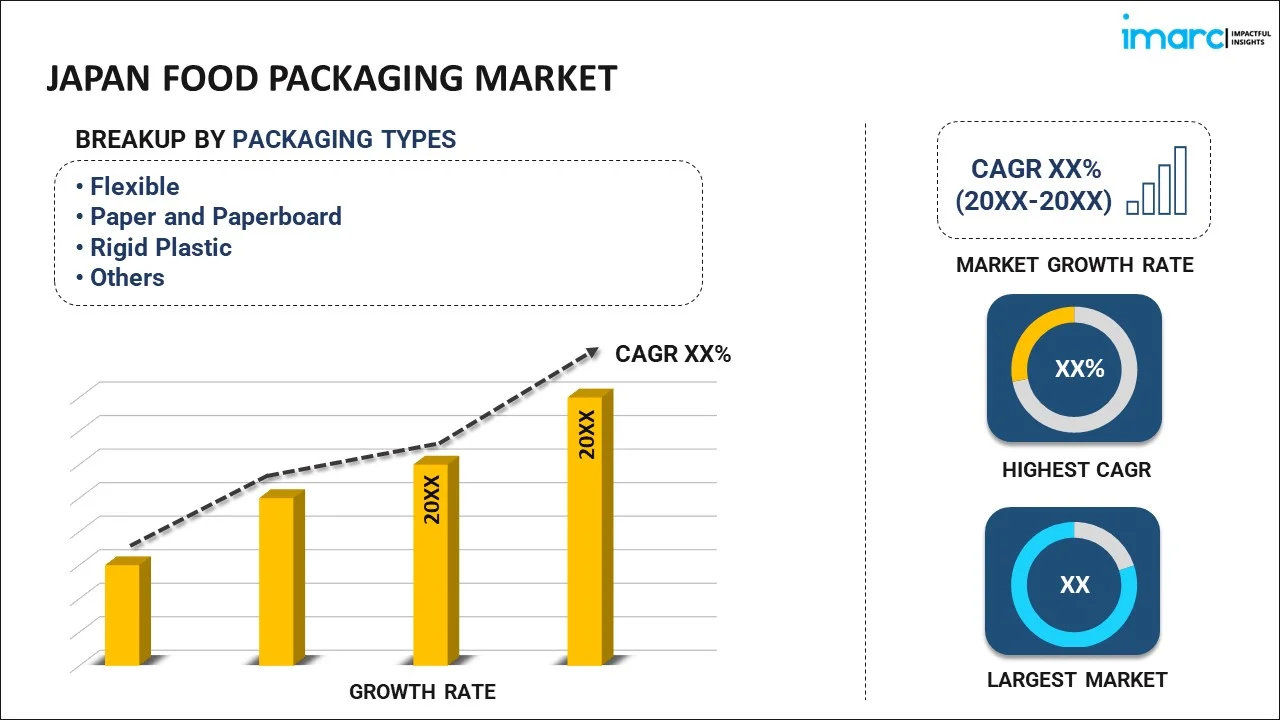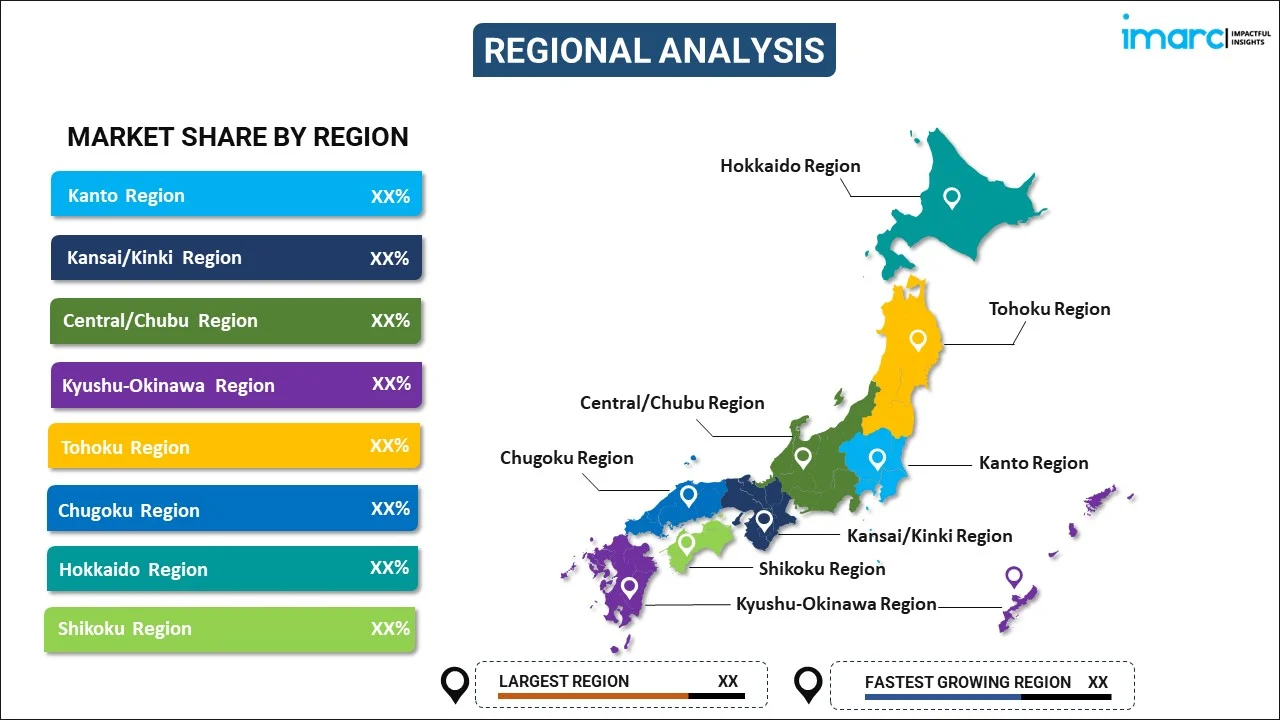
Japan Food Packaging Market Report by Packaging Type (Flexible, Paper and Paperboard, Rigid Plastic, Glass, Metal, and Others), Application (Bakery, Confectionary, Pasta, and Noodles, Dairy Products, Sauces, Dressings, and Condiments, Snacks and Side Dishes, Convenience Foods, Meat, Fish, and Poultry, Fruits and Vegetables, and Others), and Region 2025-2033
Market Overview:
Japan food packaging market size reached USD 14.6 Billion in 2024. Looking forward, IMARC Group expects the market to reach USD 22.6 Billion by 2033, exhibiting a growth rate (CAGR) of 4.62% during 2025-2033. The rising application of e-commerce and online food delivery services, which has led to an increased need for packaging that can withstand the rigors of shipping and transportation, while also providing a positive unboxing experience for consumers, is driving the market.
|
Report Attribute
|
Key Statistics
|
|---|---|
|
Base Year
|
2024 |
|
Forecast Years
|
2025-2033
|
|
Historical Years
|
2019-2024
|
| Market Size in 2024 | USD 14.6 Billion |
| Market Forecast in 2033 | USD 22.6 Billion |
| Market Growth Rate (2025-2033) | 4.62% |
Food packaging plays a vital role in the modern food industry, serving multiple functions beyond just containing and protecting food products. It is a critical component of food safety, preservation, and marketing. Effective food packaging ensures that products remain fresh and safe for consumption, extending their shelf life while preventing contamination. Moreover, food packaging plays a significant role in conveying essential information to consumers. Nutritional facts, ingredient lists, allergen warnings, and cooking instructions are just some of the crucial details that packaging must communicate clearly. Appealing and informative packaging design also serves as a powerful marketing tool, attracting consumers and influencing their purchasing decisions. In recent years, there has been a growing emphasis on sustainable and eco-friendly packaging materials as environmental concerns rise. Many companies are exploring innovative ways to reduce packaging waste, opting for recyclable, biodegradable, or reusable materials. In summary, food packaging is not just about wrapping products; it is a multifaceted aspect of the food industry that contributes to food safety, preservation, consumer information, and environmental sustainability.
Japan Food Packaging Market Trends:
The food packaging market in Japan is experiencing robust growth due to several key drivers. To begin with, changing consumer lifestyles and increasing urbanization have led to a surge in demand for convenience foods. As a result, manufacturers are constantly innovating in packaging to meet the need for on-the-go, ready-to-eat meals. Furthermore, rising health consciousness among consumers has prompted a shift towards healthier eating habits. This has fueled the demand for packaging solutions that not only preserve food freshness but also provide clear nutritional information. Moreover, stringent government regulations pertaining to food safety and labeling have significantly influenced the packaging industry. Compliance with these regulations is essential, driving companies to invest in advanced packaging technologies and materials. In addition to this, the growing awareness of environmental sustainability has pushed for eco-friendly packaging options. Sustainable packaging materials, such as recyclable and biodegradable materials, are increasingly preferred by consumers, thereby contributing to market growth. Lastly, the e-commerce boom has further accelerated the food packaging market in Japan, as online grocery shopping necessitates packaging that ensures the safe and efficient delivery of perishable goods.
Japan Food Packaging Market Segmentation:
IMARC Group provides an analysis of the key trends in each segment of the market, along with forecasts at the country level for 2025-2033. Our report has categorized the market based on packaging type and application.
Packaging Type Insights:

- Flexible
- Paper and Paperboard
- Rigid Plastic
- Glass
- Metal
- Others
The report has provided a detailed breakup and analysis of the market based on the packaging type. This includes flexible, paper and paperboard, rigid plastic, glass, metal, others.
Application Insights:
- Bakery, Confectionary, Pasta, and Noodles
- Dairy Products
- Sauces, Dressings, and Condiments
- Snacks and Side Dishes
- Convenience Foods
- Meat, Fish, and Poultry
- Fruits and Vegetables
- Others
A detailed breakup and analysis of the market based on the application have also been provided in the report. This includes bakery, confectionary, pasta, and noodles, dairy products, sauces, dressings, and condiments, snacks and side dishes, convenience foods, meat, fish, and poultry, fruits and vegetables, and others.
Regional Insights:

- Kanto Region
- Kansai/Kinki Region
- Central/ Chubu Region
- Kyushu-Okinawa Region
- Tohoku Region
- Chugoku Region
- Hokkaido Region
- Shikoku Region
The report has also provided a comprehensive analysis of all the major regional markets, which include Kanto Region, Kansai/Kinki Region, Central/ Chubu Region, Kyushu-Okinawa Region, Tohoku Region, Chugoku Region, Hokkaido Region, and Shikoku Region.
Competitive Landscape:
The market research report has also provided a comprehensive analysis of the competitive landscape. Competitive analysis such as market structure, key player positioning, top winning strategies, competitive dashboard, and company evaluation quadrant has been covered in the report. Also, detailed profiles of all major companies have been provided. Some of the key players include:
- Nihon Cellonpack Co., Ltd.
- Pack Style
- Sekisui Kasei Co., Ltd.
- Shikoku Kakoki Co., Ltd.
- Takigawa Corporation (Rengo Co., Ltd.)
- TOPPAN Inc.
- Toyo Seikan Group Holdings, Ltd.
(Please note that this is only a partial list of the key players, and the complete list is provided in the report.)
Japan Food Packaging Market Report Coverage:
| Report Features | Details |
|---|---|
| Base Year of the Analysis | 2024 |
| Historical Period | 2019-2024 |
| Forecast Period | 2025-2033 |
| Units | Billion USD |
| Scope of the Report | Exploration of Historical and Forecast Trends, Industry Catalysts and Challenges, Segment-Wise Historical and Predictive Market Assessment:
|
| Packaging Types Covered | Flexible, Paper and Paperboard, Rigid Plastic, Glass, Metal, Others |
| Applications Covered | Bakery, Confectionary, Pasta, and Noodles, Dairy Products, Sauces, Dressings, and Condiments, Snacks and Side Dishes, Convenience Foods, Meat, Fish, and Poultry, Fruits and Vegetables, Others |
| Regions Covered | Kanto Region, Kansai/Kinki Region, Central/ Chubu Region, Kyushu-Okinawa Region, Tohoku Region, Chugoku Region, Hokkaido Region, Shikoku Region |
| Companies Covered | Nihon Cellonpack Co., Ltd., Pack Style, Sekisui Kasei Co., Ltd., Shikoku Kakoki Co., Ltd., Takigawa Corporation (Rengo Co., Ltd.), TOPPAN Inc., Toyo Seikan Group Holdings, Ltd., etc. |
| Customization Scope | 10% Free Customization |
| Post-Sale Analyst Support | 10-12 Weeks |
| Delivery Format | PDF and Excel through Email (We can also provide the editable version of the report in PPT/Word format on special request) |
Key Questions Answered in This Report:
- How has the Japan food packaging market performed so far and how will it perform in the coming years?
- What has been the impact of COVID-19 on the Japan food packaging market?
- What is the breakup of the Japan food packaging market on the basis of packaging type?
- What is the breakup of the Japan food packaging market on the basis of application?
- What are the various stages in the value chain of the Japan food packaging market?
- What are the key driving factors and challenges in the Japan food packaging?
- What is the structure of the Japan food packaging market and who are the key players?
- What is the degree of competition in the Japan food packaging market?
Key Benefits for Stakeholders:
- IMARC’s industry report offers a comprehensive quantitative analysis of various market segments, historical and current market trends, market forecasts, and dynamics of the Japan food packaging market from 2019-2033.
- The research report provides the latest information on the market drivers, challenges, and opportunities in the Japan food packaging market.
- Porter's five forces analysis assist stakeholders in assessing the impact of new entrants, competitive rivalry, supplier power, buyer power, and the threat of substitution. It helps stakeholders to analyze the level of competition within the Japan food packaging industry and its attractiveness.
- Competitive landscape allows stakeholders to understand their competitive environment and provides an insight into the current positions of key players in the market.
Need more help?
- Speak to our experienced analysts for insights on the current market scenarios.
- Include additional segments and countries to customize the report as per your requirement.
- Gain an unparalleled competitive advantage in your domain by understanding how to utilize the report and positively impacting your operations and revenue.
- For further assistance, please connect with our analysts.
 Inquire Before Buying
Inquire Before Buying
 Speak to an Analyst
Speak to an Analyst
 Request Brochure
Request Brochure
 Request Customization
Request Customization




.webp)




.webp)












